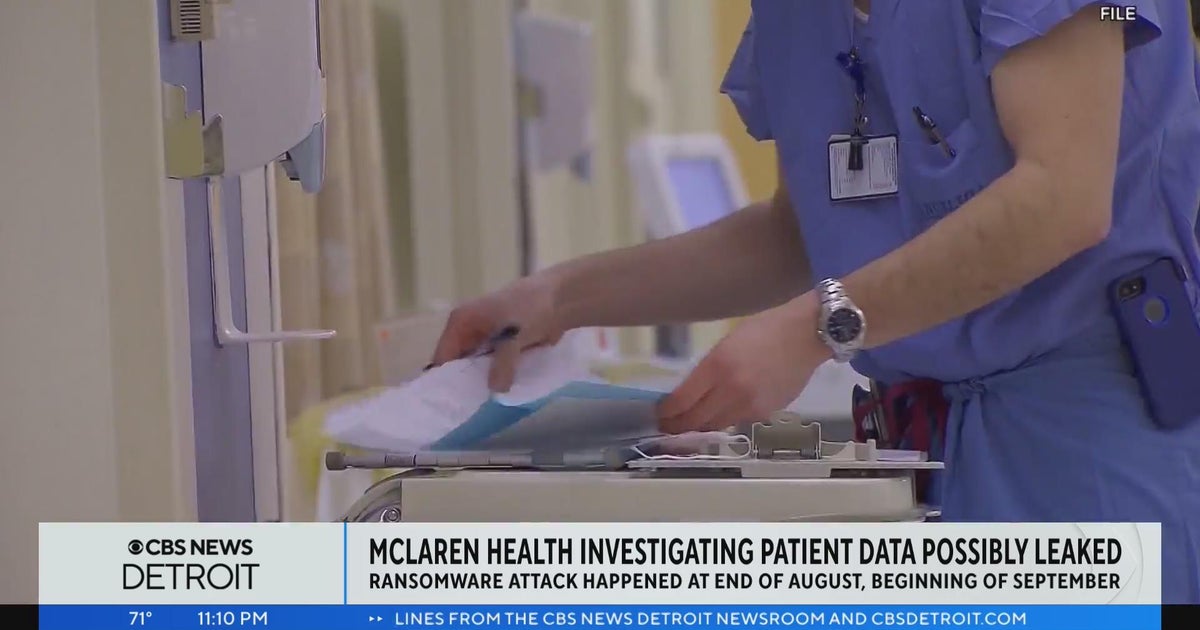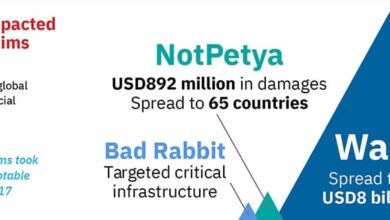
INC Ransomware Targets McLaren Health Care Hospitals
INC ransomware targets McLaren Health Care hospitals – a chilling headline that underscores the growing threat to our healthcare systems. This attack wasn’t just a data breach; it was a direct assault on patient care, potentially jeopardizing sensitive medical information and disrupting vital services. The story unfolds with a timeline of events, from the initial intrusion to the aftermath, revealing the attackers’ methods and McLaren’s response.
We’ll dive deep into the financial and reputational damage, the impact on patients, and the critical lessons learned for strengthening cybersecurity defenses in the healthcare sector.
This incident highlights the urgent need for robust cybersecurity measures within healthcare organizations. We’ll explore the specific vulnerabilities exploited by the attackers and discuss proactive steps to prevent future incidents. From enhanced endpoint protection to improved employee training, the focus shifts to building a more resilient and secure healthcare landscape. The implications extend far beyond McLaren, impacting the entire industry and underscoring the ever-evolving threat landscape.
The INC Ransomware Attack on McLaren Health Care
The ransomware attack on McLaren Health Care, attributed to the INC ransomware group, serves as a stark reminder of the vulnerability of even large healthcare organizations to sophisticated cyber threats. The incident highlighted the significant disruption that ransomware can cause, impacting patient care and operational efficiency. While the specifics of the attack remain partially undisclosed due to ongoing investigations and McLaren’s commitment to patient privacy, publicly available information paints a concerning picture.
Timeline of the Attack
The precise timeline of the McLaren Health Care ransomware attack isn’t fully public. However, reports indicate the initial breach likely occurred sometime in late 2023. Data exfiltration, the unauthorized copying of sensitive data from McLaren’s systems, followed the initial intrusion. This was subsequently followed by a ransom demand from the INC group. The exact amount of the ransom demand remains undisclosed, but such attacks often involve significant financial sums.
The response from McLaren involved immediate system shutdowns to contain the spread of the ransomware, impacting patient care and administrative functions. The full restoration of systems and data took several weeks, with a phased approach prioritizing critical services.
Affected Systems and Data
The INC ransomware attack affected a range of McLaren Health Care’s systems and data. While the exact extent of the breach remains unclear, it’s evident that the attackers targeted critical infrastructure, compromising both operational and patient data. The following table provides an estimated overview based on publicly available information and typical ransomware attack patterns. Note that the data volume and impact are estimates and may not reflect the precise situation.
| System | Data Type | Volume (Estimate) | Impact on Operations |
|---|---|---|---|
| Electronic Health Records (EHR) | Patient medical records, billing information, insurance details | Potentially terabytes | Significant disruption to patient care, billing, and administrative processes. Delayed appointments and procedures. |
| Hospital Management Systems | Patient scheduling, bed management, inventory, staff information | Hundreds of gigabytes | Disruption to hospital operations, impacting scheduling, resource allocation, and staff communication. |
| Financial Systems | Financial transactions, payroll data, vendor information | Hundreds of gigabytes | Disruption to financial operations, potentially impacting payments and reporting. |
| Network Infrastructure | Network configurations, server data, user credentials | Variable | Significant network downtime, impacting all connected systems and services. |
Attack Methods
While the precise methods used by the INC ransomware group to breach McLaren’s systems remain under investigation, common attack vectors used in similar incidents are likely to have been involved. These could include phishing emails targeting employees, exploiting known vulnerabilities in software or network devices, or using compromised credentials obtained through previous attacks. The attackers likely leveraged sophisticated techniques to move laterally within McLaren’s network, gaining access to sensitive data and critical systems before deploying the ransomware.
The use of double extortion – both encrypting data and exfiltrating it for later release or sale – is also a common tactic used by ransomware groups like INC. This creates a powerful incentive for victims to pay the ransom, even with the risks involved.
McLaren Health Care’s Response to the Attack: Inc Ransomware Targets Mclaren Health Care Hospitals
The INC ransomware attack on McLaren Health Care presented a significant challenge, demanding a swift and comprehensive response. Their actions, while initially shrouded in some secrecy due to the ongoing investigation, revealed a multi-faceted approach encompassing containment, recovery, and collaboration with external experts. The speed and effectiveness of their response likely mitigated the long-term impact of the attack, though the full extent of the damage and recovery costs remain undisclosed.McLaren’s response prioritized patient safety and the restoration of critical systems.
This involved immediate steps to isolate affected systems and prevent further spread of the ransomware. Their incident response plan, presumably well-rehearsed through regular security drills and simulations, guided their initial actions. This proactive approach likely played a crucial role in minimizing the disruption to patient care.
Containment of the Ransomware Attack
McLaren’s initial steps focused on containing the spread of the ransomware within their network. This likely involved disconnecting affected systems from the network, implementing network segmentation to isolate compromised areas, and deploying emergency patches and updates. The specific technical details remain confidential, but it’s plausible that they leveraged their existing security infrastructure, including intrusion detection and prevention systems, to identify the attack vector and limit its impact.
Their actions likely included a thorough investigation to determine the extent of the breach and the specific data compromised.
Data Restoration and System Rebuilding, Inc ransomware targets mclaren health care hospitals
Following containment, McLaren embarked on a complex data restoration and system rebuilding process. This would have involved restoring data from backups, verifying data integrity, and meticulously rebuilding affected systems. The process likely required significant time and resources, potentially involving specialized data recovery teams and system administrators. The scale of the operation would have depended on the extent of the data loss and the complexity of their IT infrastructure.
A phased approach, restoring critical systems first, would have been essential to resume operations as quickly as possible.
Collaboration with Law Enforcement and Cybersecurity Experts
McLaren’s response wasn’t solely internal. They almost certainly collaborated with law enforcement agencies and leading cybersecurity experts. This collaboration would have provided access to specialized expertise, investigative resources, and potentially intelligence on the ransomware group responsible for the attack. The involvement of external cybersecurity firms likely provided valuable insights into the attack’s techniques, allowed for a more thorough investigation, and aided in the development of more robust security measures to prevent future attacks.
This collaborative approach is a standard practice in large-scale ransomware incidents and highlights the interconnectedness of healthcare security and national security.
Impact of the Ransomware Attack on McLaren Health Care and Patients

The INC ransomware attack on McLaren Health Care had far-reaching consequences, impacting not only the healthcare provider’s finances but also patient care and its legal standing. Understanding the full extent of the damage requires examining the direct and indirect costs, the disruption to services, and the potential for long-term repercussions.
Financial Impact on McLaren Health Care
The financial burden on McLaren resulting from the ransomware attack was substantial. Direct costs included the ransom payment itself (the amount of which was never publicly disclosed, but likely significant given the size of the organization and the scale of the disruption), the cost of engaging cybersecurity experts to remediate the systems, and the expense of restoring data from backups.
Indirect costs were arguably even more damaging. Lost revenue due to service disruptions, the cost of notifying affected patients, and the potential for decreased patient trust and subsequent loss of future business all contributed to a substantial overall financial loss. Similar attacks on other large healthcare organizations have resulted in losses exceeding tens of millions of dollars, and it’s reasonable to assume McLaren faced a similarly significant financial hit.
The long-term impact on McLaren’s financial stability will likely depend on their insurance coverage, the extent of their recovery efforts, and the overall strength of their financial position before the attack.
Impact on Patient Care
The ransomware attack significantly disrupted patient care at McLaren Health Care facilities.
- Disruptions to electronic health records (EHRs) resulted in delays in accessing patient information, potentially impacting the speed and quality of diagnosis and treatment.
- Interruptions to scheduling systems caused appointment delays and cancellations, leading to inconvenience and potential worsening of patients’ conditions.
- The attack also impacted communication systems, hindering the ability of healthcare professionals to coordinate care effectively and communicate with patients and their families.
- Concerns arose regarding the potential for patient data breaches, leading to anxiety among patients and the need for extensive notification and credit monitoring services.
The extent of the impact varied across different McLaren facilities and departments, but the overall effect was a significant disruption to the delivery of timely and effective patient care. The long-term consequences for patient health and well-being remain to be fully assessed.
Legal and Regulatory Consequences
McLaren faced significant legal and regulatory consequences following the ransomware attack. The Health Insurance Portability and Accountability Act (HIPAA) mandates strict security measures to protect patient health information. Any breach of this data, even unintentional, can result in substantial fines and legal action from both the federal government (through the Office for Civil Rights) and potentially from affected patients themselves.
Further, state laws regarding data breaches and notification requirements may also apply, adding to the complexity of the legal landscape McLaren had to navigate. The reputational damage from the attack could also lead to legal challenges from patients, insurers, and other stakeholders. The precise legal and regulatory outcomes depend on the specifics of the investigation and any resulting legal proceedings.
The recent Inc. ransomware attack on McLaren Health Care hospitals highlights the urgent need for robust cybersecurity solutions. Building resilient systems requires efficient development, and that’s where exploring options like domino app dev, the low-code and pro-code future , becomes crucial. Faster development cycles could mean quicker patching and updates, a key factor in mitigating future ransomware threats against healthcare providers like McLaren.
However, the potential for substantial financial penalties and legal liabilities was undeniable.
Lessons Learned and Future Mitigation Strategies
The INC ransomware attack on McLaren Health Care highlighted critical vulnerabilities in their cybersecurity infrastructure and exposed the significant consequences of inadequate security measures within the healthcare sector. Analyzing the attack reveals several key areas for improvement, focusing on proactive measures to prevent future incidents and bolstering their overall resilience against cyber threats. This necessitates a multi-faceted approach encompassing technological upgrades, improved employee training, and a robust incident response plan.The attackers likely exploited vulnerabilities in several areas, leading to the successful infiltration and encryption of McLaren’s systems.
These vulnerabilities may have included outdated software, weak passwords, phishing attacks targeting employees, and insufficient network segmentation. Addressing these weaknesses requires a comprehensive strategy involving both technological and human elements.
Vulnerability Remediation and Infrastructure Improvements
Improving McLaren’s cybersecurity infrastructure requires a multi-pronged approach focusing on patching known vulnerabilities, strengthening access controls, and enhancing network security. This includes regularly updating all software and operating systems to the latest security patches, implementing multi-factor authentication (MFA) for all accounts, and employing robust intrusion detection and prevention systems (IDPS). Furthermore, a thorough vulnerability assessment and penetration testing should be conducted regularly to proactively identify and address potential weaknesses before they can be exploited.
Regular security audits, both internal and external, can help identify and mitigate vulnerabilities before they are exploited. For example, regular patching of known vulnerabilities in commonly used software like Microsoft Windows or outdated medical devices could have prevented initial access.
Security Measures to Prevent Future Attacks
To prevent future ransomware attacks, McLaren needs to implement a layered security approach. This involves multiple security controls working together to mitigate risk. The following specific measures are crucial:
- Enhanced Endpoint Protection: Deploying advanced endpoint detection and response (EDR) solutions across all endpoints (computers, servers, mobile devices) is critical. EDR provides real-time monitoring and threat detection capabilities, enabling quicker identification and response to malicious activity. This contrasts with traditional antivirus solutions, which primarily focus on signature-based detection.
- Improved Network Segmentation: Implementing robust network segmentation will limit the impact of a successful breach. By isolating critical systems and data from less sensitive areas, the spread of ransomware can be contained. This segmentation should include VLANs (Virtual Local Area Networks) and other network security technologies to create separate security zones.
- Employee Security Awareness Training: Regular and comprehensive security awareness training for all employees is essential. This training should cover topics such as phishing scams, social engineering tactics, password security, and safe internet practices. Simulations of phishing attacks can help assess and improve employee awareness and responsiveness.
- Data Backup and Recovery: Implementing a robust data backup and recovery strategy is crucial. Regular backups should be stored offline and tested regularly to ensure their recoverability. This allows for swift recovery in case of a ransomware attack, minimizing downtime and data loss. The 3-2-1 backup rule (3 copies of data, on 2 different media, with 1 copy offsite) should be followed.
- Incident Response Plan Development and Testing: A comprehensive incident response plan is crucial. This plan should Artikel procedures for identifying, containing, eradicating, and recovering from a cybersecurity incident. Regular testing and drills are essential to ensure the plan’s effectiveness and to train personnel on their roles and responsibilities. This includes tabletop exercises to simulate different scenarios.
Hypothetical Incident Response Plan
A robust incident response plan should address the weaknesses exposed by the INC ransomware attack. This plan should include the following phases:
- Preparation: This phase involves establishing a dedicated incident response team, defining roles and responsibilities, developing communication protocols, and creating a comprehensive incident response plan document. Regular security awareness training should be integrated into this phase.
- Identification: This involves detecting the ransomware attack through monitoring systems, user reports, or unusual network activity. This stage should trigger the activation of the incident response plan.
- Containment: This phase focuses on isolating infected systems to prevent the spread of the ransomware. This may involve disconnecting affected systems from the network and implementing network segmentation to contain the attack.
- Eradication: This involves removing the ransomware from infected systems, restoring systems from clean backups, and patching any vulnerabilities that were exploited. Forensic analysis of the attack is crucial during this stage.
- Recovery: This phase focuses on restoring systems and data from backups, validating data integrity, and resuming normal operations. This may involve a phased approach, prioritizing critical systems and applications.
- Post-Incident Activity: This involves conducting a thorough post-incident review to identify lessons learned, improve the incident response plan, and implement preventive measures to avoid future attacks. This phase includes documenting the incident and sharing the findings with relevant stakeholders.
Broader Implications of the Attack

The McLaren Health Care ransomware attack serves as a stark reminder of the escalating threat ransomware poses to the healthcare industry. This isn’t an isolated incident; it’s a symptom of a larger, increasingly sophisticated and frequent problem that demands immediate and comprehensive attention. The sheer volume of sensitive patient data held by healthcare organizations makes them prime targets, and the potential consequences of a successful attack – from disrupted care to significant financial losses and reputational damage – are severe.The attack highlights the need for a proactive and multi-layered approach to cybersecurity within healthcare.
It underscores the limitations of relying solely on reactive measures and the critical importance of investing in robust preventative strategies, including employee training, regular security audits, and advanced threat detection systems. The financial and operational impact of a successful attack can be crippling, and the long-term reputational damage can be difficult, if not impossible, to overcome.
Frequency and Sophistication of Healthcare Ransomware Attacks
Ransomware attacks targeting healthcare organizations are increasing in both frequency and sophistication. Attackers are employing more advanced techniques, such as exploiting vulnerabilities in legacy systems or using phishing campaigns specifically designed to target healthcare workers. The financial incentives are high, given the value of the data held by these organizations and the willingness of some institutions to pay ransoms to avoid further disruption.
This creates a vicious cycle where attackers are incentivized to continue refining their tactics and targeting more vulnerable organizations. For example, the Colonial Pipeline attack in 2021, while not directly targeting healthcare, demonstrated the potential for widespread disruption caused by ransomware targeting critical infrastructure, indirectly impacting healthcare services reliant on those systems.
Comparison with Other Significant Attacks
The McLaren Health Care attack shares similarities with other significant ransomware attacks against healthcare providers, such as the attacks on Universal Health Services in 2020 and the MedStar Health attack in 2016. All these incidents involved the encryption of sensitive patient data, disruption of hospital operations, and significant financial and reputational costs. However, differences exist in the specific ransomware used, the attackers’ tactics, and the organizations’ responses.
For instance, the specific vulnerabilities exploited and the ransom demands might vary. The effectiveness of each organization’s incident response plan also played a crucial role in determining the extent of the damage and the recovery time. The comparison of these incidents highlights the need for adaptable and robust security measures that can effectively counter a range of attack vectors.
Challenges in Protecting Sensitive Patient Data
Healthcare providers face numerous challenges in protecting sensitive patient data. These challenges include: the sheer volume of data, the complexity of healthcare IT systems (often including legacy systems with known vulnerabilities), budget constraints that limit investment in robust cybersecurity infrastructure, and the ongoing shortage of skilled cybersecurity professionals. Furthermore, the regulatory landscape, including HIPAA compliance in the US, adds another layer of complexity.
Maintaining compliance while simultaneously implementing cutting-edge security measures requires significant resources and expertise. The human element remains a critical vulnerability, with phishing attacks and social engineering often proving highly effective in bypassing technical safeguards. Therefore, a holistic approach that encompasses technical, procedural, and human elements is essential for effective data protection.
Final Review

The INC ransomware attack on McLaren Health Care serves as a stark reminder of the vulnerabilities within our healthcare system. The incident underscores the critical need for proactive cybersecurity measures, robust incident response plans, and a collaborative approach involving healthcare providers, cybersecurity experts, and law enforcement. While the immediate impact on McLaren is significant, the broader implications for the healthcare industry are even more profound, pushing us to re-evaluate and strengthen our defenses against increasingly sophisticated cyber threats.
The lessons learned from this attack must fuel a concerted effort to safeguard patient data and ensure the continued delivery of quality healthcare.
Questions and Answers
What type of data was stolen in the McLaren Health Care ransomware attack?
While the exact nature and volume of stolen data haven’t been publicly disclosed in full, it’s likely to include patient medical records, financial information, and internal operational data.
Did McLaren pay the ransom?
McLaren hasn’t publicly confirmed whether or not a ransom was paid. Paying ransoms is generally discouraged as it doesn’t guarantee data recovery and emboldens attackers.
What legal ramifications could McLaren face?
Potential legal consequences include HIPAA violations, lawsuits from affected patients, and regulatory fines from government agencies.
How can other healthcare organizations learn from this attack?
By investing in robust cybersecurity infrastructure, conducting regular security audits, implementing employee training programs, and developing comprehensive incident response plans.





